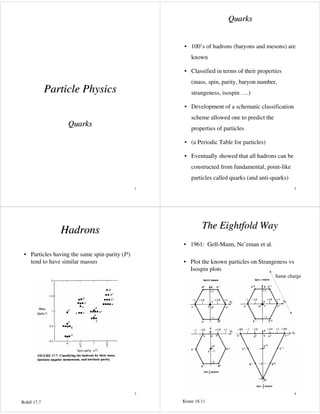
Quarks
- 1. Quarks • 100’s of hadrons (baryons and mesons) are known • Classified in terms of their properties (mass, spin, parity, baryon number, Particle Physics strangeness, isospin ….) • Development of a schematic classification scheme allowed one to predict the Quarks properties of particles • (a Periodic Table for particles) • Eventually showed that all hadrons can be constructed from fundamental, point-like particles called quarks (and anti-quarks) 1 2 Hadrons The Eightfold Way • 1961: Gell-Mann, Ne’eman et al. • Particles having the same spin-parity (Jπ) tend to have similar masses • Plot the known particles on Strangeness vs Isospin plots Same charge 3 4 Rohlf 17.7 Krane 18.11
- 2. The Eightfold Way The Eightfold Way Successful in predicting particles A building block ? Are quarks real or just nice maths ? 5 6 Krane 18.12 & 13 Quarks Mesons • All quarks are spin-1/2 fermions • A quark-antiquark pair qq • Fractional charge + 2 e or 3 −1e 3 • Mesons have B = 0. {+ 1 − 1 = 0} 3 3 • Baryon number = +1 3 • 9 bound states (mesons) from the 3 basic quarks: • Intrinsic parity is +1 uu ud us du dd ds su sd ss + + − − η π K π π 0 K 0 K K 0 η′ • Initially, 3 quark “flavours” Flavour Name Charge (e) • (The , ,π 0 η η ′ are in fact admixtures of qq pairs) u Up +2/3 • “Pseudoscalar Mesons” d Down −1/3 s Strange − 1/3 7 8
- 3. Mesons Mesons • These 9 mesons form an Octet (8) and a • Lowest energy state has the quark and anti- Singlet (1 – the η′). with l = 0 quark spins ↑↓ • Interchange quarks e.g. d↔s & d ↔s π (q ) = −π (q ) fermions ∴ π (q q ) = π (q ) ⋅ π (q ) ⋅ (−1) l = −1 η ′ ⇒ (uu , dd , ss ) η′ → η′ • The lowest energy state of a meson has π − Same particle J =0 K0 = d s → K 0 = ds • Excited energy state has the quark and with l = 0 anti-quark spins ↑↑ Different particles J π = 1− 9 10 Baryons Baryons • A quark triplet • Lowest energy state has the quark spins with ↑↓↑ l =0 • Baryons have B = +1. qqq π (q ) = −π (q ) fermions • Antiparticles have B = −1 qqq ∴ π (q qq ) = π (q ) = +1 p = uud , n = udd π ( q q q ) = π ( q ) = −1 Λ0 = uds, Λ0 = u d s Proton u u d uud • The lowest energy state of a baryon has π 1+ Q +2/3 +2/3 −1/3 +1 J = 2 Spin +1/2 +1/2 +1/2 +1/2 • Excited energy state has the quark spins with ↑↑↑ B 1/3 1/3 1/3 +1 l =0 3+ T +1/2 +1/2 +1/2 +1/2 Jπ = 2 T3 +1/2 +1/2 −1/2 +1/2 11 12
- 4. Colour Charm • 19** Discovery of the Ω− • 1974 Stanford and Brookhaven: • Strangeness: S = −3 ⇒ sss Discovery of the J / ψ meson • Spin = 3/2 so ↑↑↑ • Cannot be constructed from the u, d, and s quarks and anti-quarks. • 3 ‘s’ quarks, in the same quantum state – violates Exclusion Principle. • Must be a fourth quark --- “Charm (c)”. • Introduce another property “Colour” or “Colour Charge” q=+2e 3 • NOTHING to do with visual colour • So, we have 3 quarks with the same • Yet another introduced property, u, d and s ‘flavour’ i.e. ‘s’ but different ‘colours’. quarks have charm = 0. The c quark has • Red, Green & Blue so when they’re charm = +1 combined, the resulting baryon is White i.e. ‘Colour Neutral’. • Mesons are also ‘Colour Neutral’ e.g. Red & Anti-Red 13 14 Bottom (“Beauty”) Quarks • 1977 Fermilab: Discovery of the Υ • Cannot be constructed from the u, d, s and Flavour Name Charge (e) c quarks and anti-quarks. • Must be a fifth quark --- “Bottom (b) or u Up +2/3 Beauty”. d Down −1/3 q=−1e 3 s Strange −1/3 Top (“Truth”) c Charm +2/3 • Reason to suspect there are 3 families of b Bottom −1/3 quark pairs, just like the 3 generations of leptons t Top +2/3 • 1997 Fermilab: Evidence for the top quark q=+2e 3 15 16
